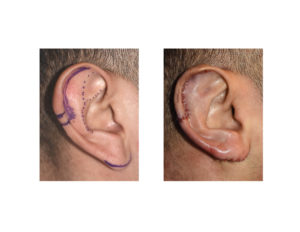The vertically long ear is one that appears disproportionate to other facial features. Generally if the length of the ear is greater than that of the nose, for example, it can be judged to be too long. But no matter how it is measured of the patient thinks the ear is too long then it is.
When performing a setback otoplasty for protruding ears, it is not rare to see that the ears are also vertically long. While sometimes this can be an illusion because of the ear’s degree of outward protrusion, measurements and trial reshaping of the ear can confirm if it is really too long. If this diagnosis is missed before surgery, the setback ear may look better but still be too long. In some cases of how setback otoplasty sutures are placed, it can even make the long ear look even longer.
In the Online First edition of the February 2017 European Journal of Plastic surgery an article was published entitled ‘Upper Third Ear Reduction with a Posterior Approach’. In this paper, the authors report a specific technique for the reduction of the upper third with a posterior approach based on resection of the scapha and remodeling of the posterior skin excess. This is an ear reshaping technique that is combined with setback otoplasty.

But when combining vertical ear reduction with a setback otoplasty, it is not wise to use the traditional anterior scaphal cartilage and skin resection technique. While it is not the cartilage resection that is the problem but the placement of incisions on both the front and backside of the ear. For this reason removing cartilage only from the posterior approach is done at the time of the setback otoplasty. Folding the ears back will allow the scaphal cartilage gap to close and shorten the height of the ear somewhat. Any skin excess can then also be removed.
Dr. Barry Eppley
Indianapolis, Indiana


